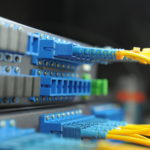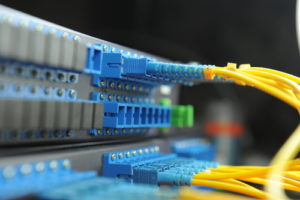
Up in rural northern Vermont, it took until the 1960s to run power lines to some towns—decades after the rest of America got turned on. These days, it’s the digital revolution that remains but a rumor in much of rural America.
Dial-up user Val Houde knows this as well as anybody. After moving to East Burke, Vt., four years ago, the 51-year-old mother of four took a correspondence course for medical transcription, hoping to work from home.
She plunked down $800, took the course, then found out the software wasn’t compatible with dial-up internet, the only kind available to her.
Selling items on eBay, watching videos, playing games online? Forget it.
The connection from her home computer is so slow, her online life is one of delays, degraded quality, and “buffering” warning messages. So she waits until the day a provider extends broadband to her house.
“I feel like these companies, they don’t care about these little pockets of places,” she said one night recently, showing a visitor her computer’s slow internet service. “And I know we’re not the only ones.”
For Houde and millions of other Americans laboring under slow or no internet service, help is on the way.
Bolstered by billions in federal stimulus money, an effort to expand broadband internet access to rural areas is under way, an ambitious 21st-century infrastructure project with parallels to the New Deal electrification of the nation’s hinterlands in the 1930s and 1940s—and one with important implications for rural education.
President Barack Obama emphasized the importance of high-speed internet access in his State of the Union address last week.
“To attract new businesses to our shores, we need the fastest, most reliable ways to move people, goods, and information—from high-speed rail to high-speed internet,” Obama said.
In the Depression, it was power to the people—for farm equipment and living-room lamps, cow-milking machines, and kitchen appliances. Now, it’s online access—to YouTube and digital downloads, to video conferencing and Facebook, to eBay and Twitter.
“Rural areas all across the country are wrestling with this, somewhat desperately,” said Paul Costello, executive director of the Vermont Council on Rural Development. “Young people who grow up with the media will not live where they can’t be connected to digital culture. So most rural communities have been behind the eight ball.”
Seventy years ago, President Franklin Delano Roosevelt realized that if private industry wouldn’t run power lines out to the farthest reaches of rural areas, it would take government money to help make it happen. In 1935, the Rural Electrification Administration was established to deliver electricity to the Tennessee Valley and beyond.
Now, money from the American Recovery and Reinvestment Act is doing the same with broadband, which is typically defined as DSL (digital subscriber line), cable modem, fiber optic, or fixed wireless.
The stimulus act set aside $7.2 billion for expansion of broadband access, believing it would spur economic growth, boost educational opportunities, and create jobs.
The money has jump-started what were existing efforts by states and telecommunications providers to bridge the digital divide of rural America.
In its national broadband plan issued last year, the Federal Communications Commission pinpointed schools’ use of online resources as one of the key targets of the stimulus-funded expansion efforts.
“With broadband, students and teachers can expand instruction beyond the confines of the physical classroom and traditional school day,” the plan says. “Broadband can also provide more customized learning opportunities for students to access high-quality, low-cost, and personally relevant educational material.”
Schools in many rural districts lack that now.
“We sorely need fiber-optic in our community,” said Robert Brinkley, director of technology for the North Country Supervisory Union school district in Vermont.
The 13 schools in his district share a T-1 line whose bandwidth is so small that whenever a video field trip is planned for a class, all the other users on the system have to stop using eMail first.
“The picture doesn’t just get poor, we lose the connection. Whether it’s NASA or the Cleveland Museum of Art, we’ll lose the connection or it’ll drop completely,” said Brinkley.
A U.S. Commerce Department report last year showed that 65.9 percent of urban households subscribed to broadband in 2009, compared with 51 percent of rural households. There are several reasons for the rural shortfall, but lack of availability is the most often cited.
Consumers in rural states have been left behind, either because their homes are too far from one another, mountains make construction expensive, or providers have lacked the capital to justify the investment:
• In Kansas, Rural Telephone Service Co., Inc. got $100 million in stimulus loans and grants to extend broadband into unserved areas.
“Because of the economic climate that we live in—declining population, small farms being bought up by larger operators—the more technology and more access to information that those customers can have, the more likely they are to be able to stay in business,” said Rhonda Goddard, the company’s chief operating officer. “It’s revolutionary out there, for them to have access to the information they need to keep their business running—access to the markets, being able to buy supplies and equipment from the region instead of just from their local market. It opens doors. It increases competitiveness. It props up business.”
• In Colorado, mountains and vast stretches between farms and ranches on the plains have made it difficult for companies to justify spending millions of dollars to lay fiber-optic cable to connect far-flung residents.
There, a public-private partnership won $100 million in stimulus money to try to expand high-speed internet access to all Colorado school districts and to libraries and key institutions across the state. Some of the money will go to laying fiber and erecting new microwave towers to deliver broadband into areas that need them.
• In Texas, where 96 percent of households have broadband, $8 million in stimulus money is funding a five-year effort that includes mapping, data collection, and technical assistance in hopes of reaching the 285,550 now-unserved households. Dave Osborn, CEO of Valley Telephone Cooperative Inc., said his company serves an area of roughly 1,700 square miles in south Texas with a population of 30,000. Stimulus money is key, he says.
“It takes a whole lot of money to serve this [population],” Osborn said. “At the end of the day, there’s no way I can spend $14,000 on a line and bill a customer $16 a month. We couldn’t do it without [the federal dollars].”
Obama said the broadband goals far exceed convenience.
“This isn’t just about faster internet or fewer dropped calls,” the president said. “It’s about connecting every part of America to the digital age. It’s about a rural community in Iowa or Alabama where farmers and small business owners will be able to sell their products all over the world. It’s about a firefighter who can download the design of a burning building onto a hand-held device; a student who can take classes with a digital textbook; or a patient who can have face-to-face video chats with her doctor.”
In some parts of rural America, the issue isn’t just making broadband available. It’s convincing holdouts that there’s a benefit to it.
A survey released Jan. 13 by the National Telecommunications Cooperative Association—a trade association for rural telecoms—found that the overall broadband subscriber “take rate” for its member companies is only 55 percent, up from 38 percent a year ago.
“It’s kind of one of those ‘If you build it, will they come?’ things,” said CEO Shirley Bloomfield. “It’s one thing when you put in phone service. You may only have five customers at first, but you knew people would sign up. Now, you put out the broadband … and you’re doing a proposition of ‘Do you get enough customers to make it worth your while?’”
In Vermont, the rugged landscape of the Green Mountains, combined with the spread-out locations of the state’s 620,000 people, has blocked or impeded the building of infrastructure for telephone, transportation, and electricity, among other things.
The last towns to get electricity were the hamlets of Granby and Victory, in 1963, following years of fund raising, including a “Holiday in the Hills” weekend in 1959 in which residents showed visitors how to get by using oil lamps and wood cookstoves.
Even now, utility crews have to use draught horses to haul poles and cables to places that trucks can’t go.
“It’s not as easy as some of the other big flat states in the Midwest, where you put the plow down and you just head on out, because they’re in sandy soil they can bury their cable in,” said Kurt Gruendling, vice president of marketing and business development for Waitsfield and Champlain Valley Telecom.
“In Vermont, in particular, we say we’re ‘topographically challenged.’ We have a lot of nooks and crannies,” said Deborah Shannon, director of broadband outreach and coordination for the Vermont Telecommunications Authority.
Former Gov. Jim Douglas and various providers had pledged to get broadband to all corners of Vermont by the end of 2010, but a combination of factors—including the market’s collapse in 2008—prevented that.
Enter the stimulus.
Vermont Telephone is getting $116 million in grants and loans to extend wireless broadband to anchor institutions and unserved homes and businesses in Vermont and parts of neighboring New York and New Hampshire.
The Vermont Telecommunications Authority, in conjunction with internet service provider Sovernet Communications, is using $33.4 million in stimulus funds to build a 773-mile fiber-optic backbone that will make up the so-called “middle mile” of service, allowing schools, state buildings, and community centers to hook up to the main trunk. The “last mile” is from there to the home.
“Without the stimulus, the private sector would not have been able to do this, and the state would not have been able to develop its plans to push higher-capacity fiber connections out into our most rural areas,” Shannon said.
Meanwhile, Valerie Houde waits.
“I know there are a lot of people out there, like us, who would greatly benefit from having broadband, and with the money the state got for expanding service, it seems something should change, finally, as long as the money goes where it’s supposed to and not into politicians’ and corporate executives’ pockets,” she said.
- Extron AV Switching, Streaming, and Control Systems Aid Higher Learning at Idaho’s First Medical School - June 1, 2021
- Extron XTP, Streaming, and Control Systems Empower Point Park University’s Varsity Esports Program - June 1, 2021
- Extron NAV Series Delivers AVoIP Throughout Allied Health Veterans Hall at UNC Wilmington - June 1, 2021
